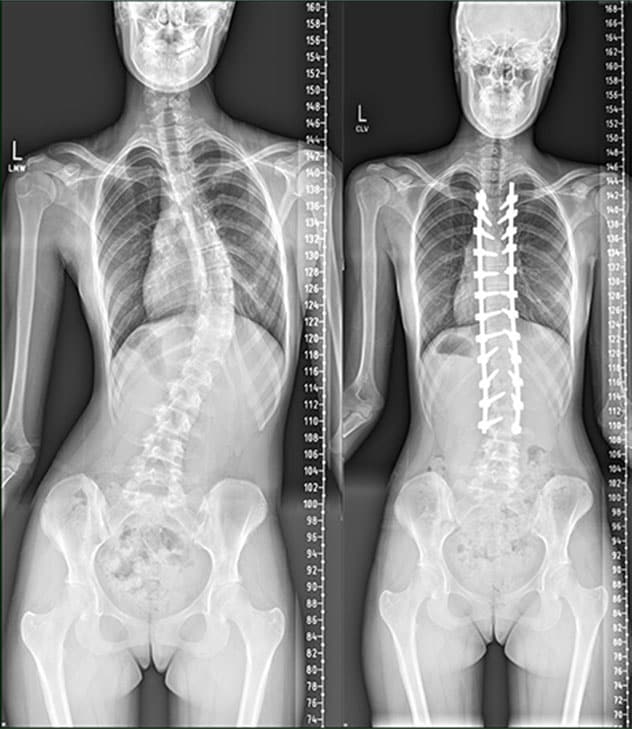Oct. 26, 2021
Mayo Clinic's approach to scoliosis stresses understanding the disease process and, if indicated, using the latest technology to provide the safest possible spinal surgery. As a comprehensive center, Mayo Clinic can apply this approach to patients regardless of age.
"Having neurosurgeons with strong expertise in spinal mechanics allows for a continuum in practice that doesn't revolve around age," says Jamal McClendon, Jr., M.D., a neurosurgeon at Mayo Clinic in Phoenix/Scottsdale, Arizona. "Our goal is to find the nuances in an individual patient's disease, irrespective of age."
Correcting severe curvature

Correcting severe curvature
X-rays show a young adult's spine before and after scoliosis surgery.
Mayo Clinic's campus in Arizona now provides scoliosis surgery for young adult and pediatric patients in conjunction with Phoenix Children's Hospital. Pediatric patients with scoliosis have access to Mayo Clinic's imaging resources, including augmented reality and 3D intraoperative viewing capabilities.
"Our technology helps us to lower the risk of complications and radiation exposure, which has lifelong implications for our young patients," Dr. McClendon says.
Idiopathic scoliosis typically occurs during children's peak growth period between ages 13 and 15. "Curvature that develops at that time can impact not only individuals' spinal function but also their confidence," Dr. McClendon says. "Straightening badly misaligned spines removes that worry so young people can focus on everything else that is happening in their lives."
Real-time 3D visualization
Mayo Clinic specialists have the expertise to use new technologies to their full potential. A video published in the May 2020 issue of World Neurosurgery shows Dr. McClendon and colleagues performing surgery on a 17-year-old boy with idiopathic scoliosis. The procedure is done in a hybrid operating room with augmented reality and a novel 3D imaging modality. "Augmented reality helps us understand the nuances of a patient's anatomy and provides real-time 3D visualization of screw trajectory to minimize screw malposition," Dr. McClendon says.
The 3D imaging modality is used after screw placement to ensure proper positioning. "The new imaging technology provides a wider exposure than conventional techniques," Dr. McClendon says. "Surgical precision is increased, and operative time and radiation exposure are reduced. As a result, the treatment that we're able to provide for adolescent scoliosis is quite safe."
As a multisite center, Mayo Clinic has deep experience with the treatment of adolescent scoliosis. Neurosurgeons from all three campuses routinely collaborate with colleagues on challenging conditions. "Mayo Clinic is able to provide the comfort level of comprehensive care for all ages," Dr. McClendon says.
For more information
McClendon J, et al. Use of pheno room, augmented reality, and 3-rod technique for 3-dimensional correction of adolescent idiopathic scoliosis. World Neurosurgery. 2020;137:291.
Refer a patient to Mayo Clinic.